Privy and Klaviyo are well-known players in the email marketing world.
Choosing between them isn’t a walk in the park. It comes down to what each tool offers and how well it suits your needs.
Luckily, this detailed comparison is here to help you find the best email marketing platform for your business.
We’ll keep things straightforward, showing you what features make each tool unique and how it can benefit you. So, you’ll be able to select the right tool that fits your budget and can meet your email-sending needs.
Now, let’s look into this comparative review of Privy vs Klaviyo to see which one could help improve your email marketing game.
Privy vs Klaviyo: Quick overview
Privy holds a solid 4.6 rating on the Shopify App Store, whereas Klaviyo has garnered a healthy rating of 3.8 out of 5. Both tools are excellent email marketing solutions, and user reviews provide valuable insights into their practical advantages.
Privy stands out with its user-friendly interface and exceptional list-building features, making it a distinctive choice.
Klaviyo, although it has a steeper learning curve, is praised for its advanced marketing automation and potential to drive revenue growth. Its simple automated flows and variety of customizable templates enhance its effectiveness for businesses of various sizes.
While these reviews show user satisfaction and tool performance, there’s more to discover about Privy and Klaviyo.
Let’s start with a quick side-by-side comparison before we delve into specific details.
Klaviyo vs Privy: Feature by feature
Privy and Klaviyo are powerful tools that can take your email marketing to the next level. But to choose the best one for your business, it’s essential to examine their specific features.
Let’s thoroughly compare both tools and decide on the winner in each category we’ll explore.
Ease of getting started
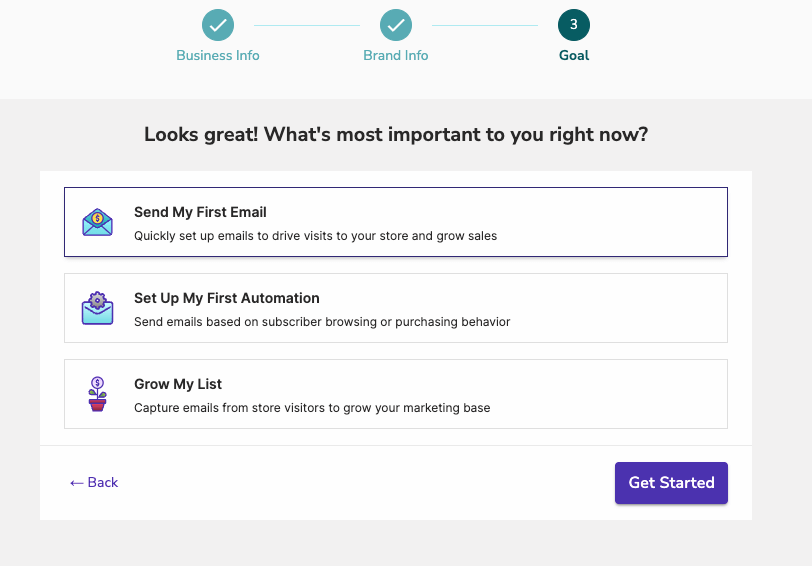
One notable advantage shared by both Privy and Klaviyo is that they don’t require your credit card information upfront. In addition to a risk-free signup process, Klaviyo presents you with just the right questions during onboarding.
Both tools offer an organized, user-friendly interface once you’re logged in.
In Privy, you’ll find well-organized account settings that are conveniently accessible. Its interface strikes a harmonious balance, providing a modern look without overwhelming users. Additionally, its logical menu structure allows an intuitive navigation experience.
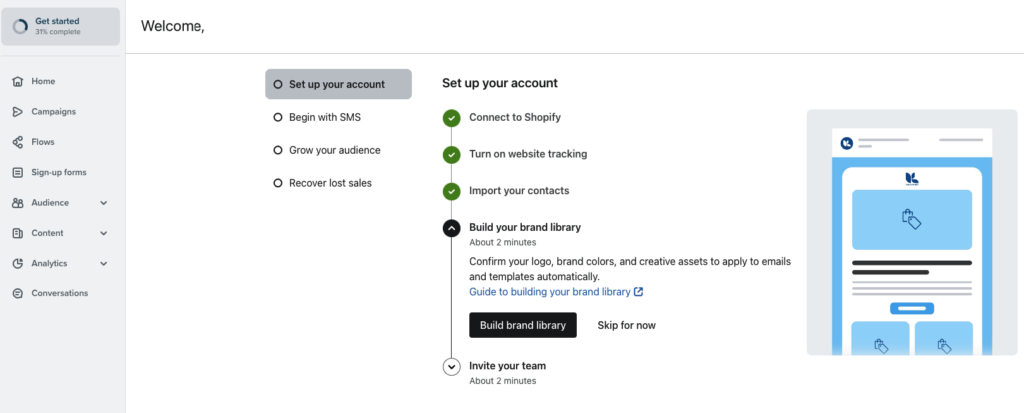
On the other hand, Klaviyo’s interface is also user-friendly. However, one potential drawback is that certain features may require a bit of a learning curve.
It’s a draw. Both Privy and Klaviyo offer visually appealing and user-friendly interfaces.
Building an email campaign
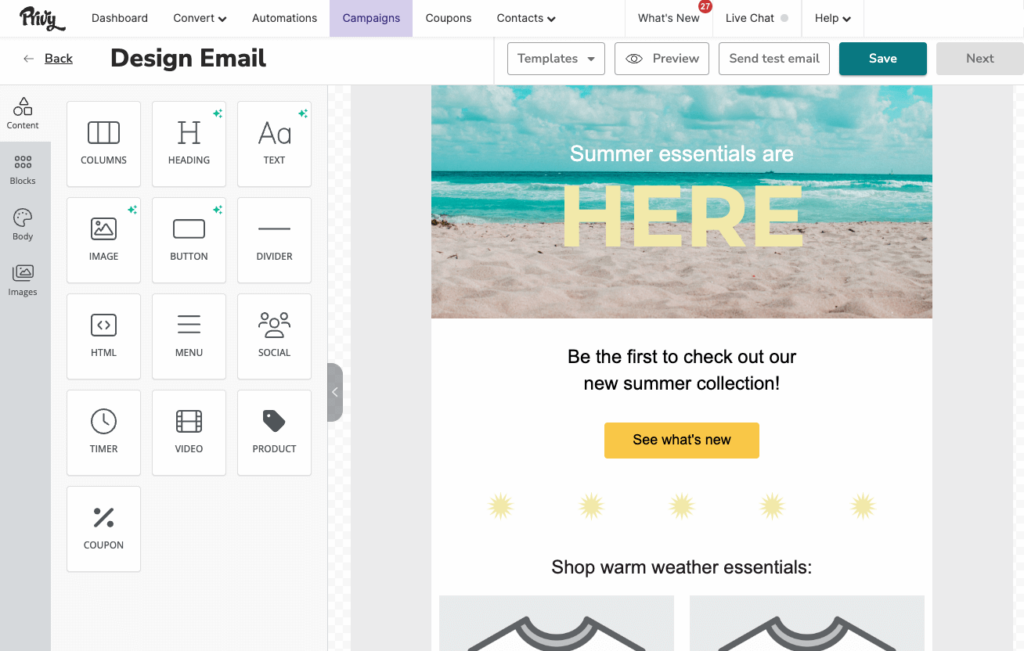
Privy simplifies email building. You can select a design, customize it, and add necessary details effortlessly. We find it very convenient that its interface resembles other platforms. The consistent logic and email-building principles shared across email service providers make it easy to switch when needed.
Klaviyo’s email builder also encompasses rich functionality, including an appealing product block sourced directly from your store.

Klaviyo offers 90+ templates that cater to various occasions and styles. Although Privy offers over 20 email templates, a broader variety for different occasions would be beneficial. It’s also important to note that while Privy’s forms can be tested, emails lack this capability.
Privy equips you with elements tailored for ecommerce, such as product showcases, coupons, timers, and AI-generated text. You can even enhance emails with stock photos from their database.
Klaviyo excels in personalization. Its standout features include displaying products in emails based on recent browsing or likes, an AI-powered Subject Line Assistant, and mobile push notifications for ecommerce apps.
However, the absence of a unique discount code generator is noticeable.
While Klaviyo’s email builder offers extensive capabilities, becoming accustomed to it might take longer than tools like MailerLite and Omnisend.
Klaviyo wins the round. It outshines Privy with its advanced personalization capabilities, A/B testing and an extensive email templates library.
Marketing automation
Getting your marketing tasks done without too much effort is important, and both Privy and Klaviyo have ways to help you with that.
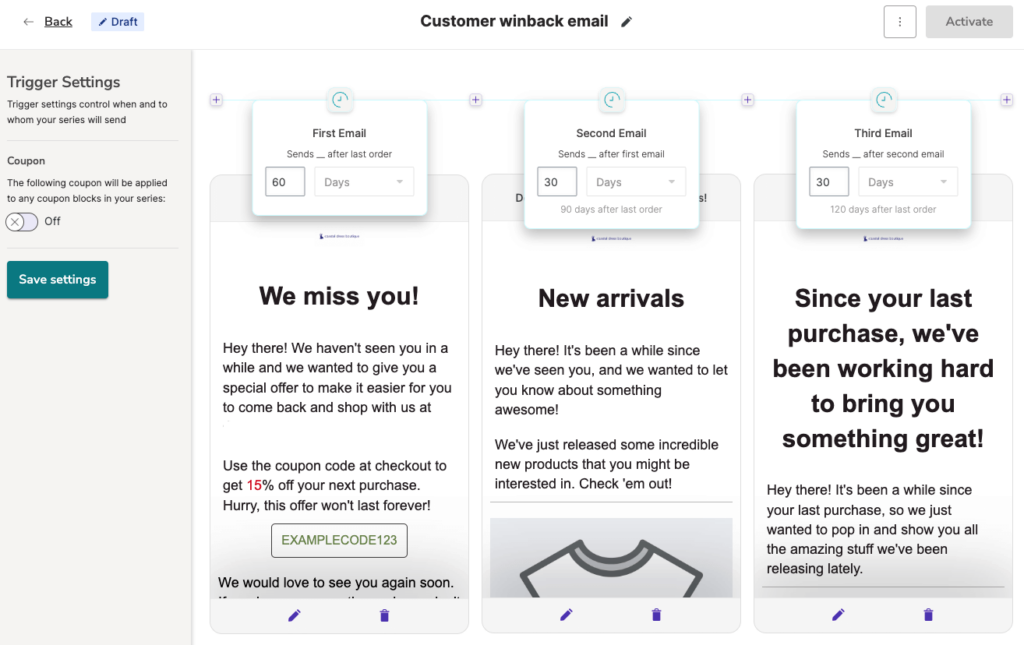
Privy’s tools for automation are easy to understand, which is great if you’re just starting with ecommerce. But if your business is already established, you might find them a bit basic.
You can use five ready-made workflows in Privy, including:
- Abandoned carts emails
- Abandoned carts SMS
- Customer win-back emails
- Welcome emails
- Purchase follow-up emails
However, there’s a notable limitation. You can’t integrate other marketing channels into Privy’s workflows. You have to choose either emails or SMS, but not both together in the same communication flow. Also, the feature that allows you to build custom automation is absent in Privy.
Meanwhile, Klaviyo has one of the most robust marketing automation functionalities. But while it offers numerous customization possibilities when creating a flow, it can quickly become overwhelming for beginners.
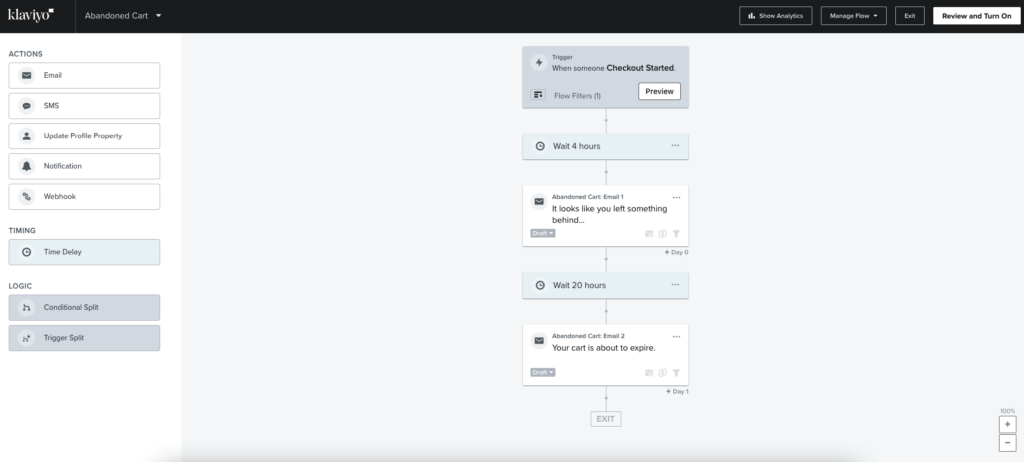
Klaviyo’s automation tools are similar to those of other popular ESPs. They offer an extended list of triggers and advanced options, like conditional splits and webhooks. Webhooks might need a certain degree of specialized knowledge, though.
Klaviyo has different sets of plug-and-play automated workflows, including:
- Welcome series
- Abandoned carts
- Browse abandonment
- Customer “Thank you”
- Customer win-back
- Product review/cross-sell
A standout feature of Klaviyo is the ability to seamlessly integrate SMS into your workflows. This allows you to include both email and SMS in the same communication flow, enhancing the effectiveness of engagement strategies.
Klaviyo’s tools also have lots of personalization capabilities, which help you create tailored and effective automated campaigns.
Klaviyo takes the lead here. It wins with its advanced automation options and superior personalization features.
Signup forms and landing pages
Both Privy and Klaviyo provide ready-made forms. However, Privy takes a clever approach by offering successful popups created by its user base as ready-made options. This allows you to select effective popups without starting from scratch, saving you time and effort.
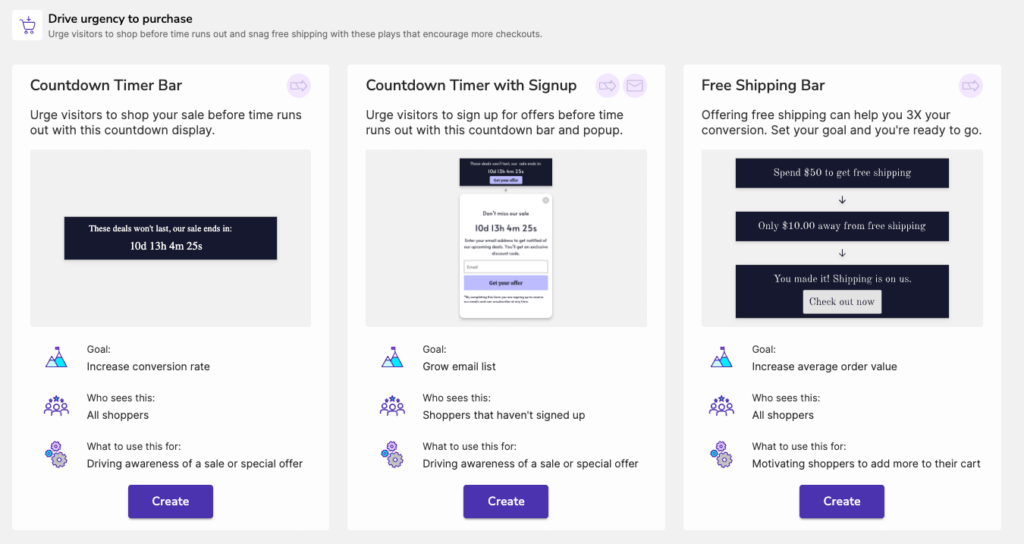
Privy and Klaviyo’s forms are attractive and customizable. Privy’s forms feature modern and appealing designs, catering to various needs. Likewise, Klaviyo provides a range of diverse forms, including popups, flyouts, embeds, and full-page options, all of which capture attention effectively.
While Klaviyo lacks gamification features, Privy offers a game-like feature called “Spin to Win,” reminiscent of features found in Omnisend.
When it comes to analytics, both Privy and Klaviyo provide all the essential stats you need.
Both tools allow you to track form performance metrics, such as signup count, signup rate, and device type. However, Privy offers a valuable feature that lets you compare your results to industry averages, which can be pretty helpful.
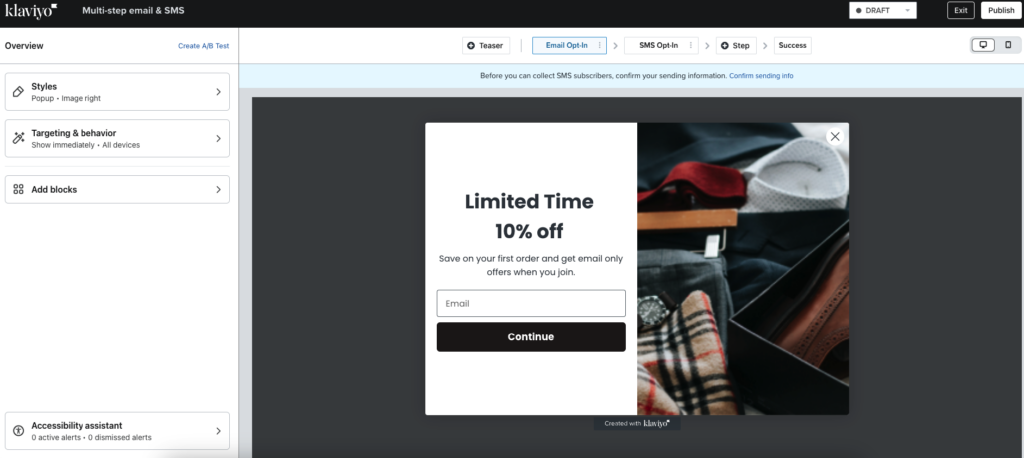
While Klaviyo lacks comprehensive landing page functionality, it compensates by allowing its full-page signup forms to serve as makeshift landing pages if configured properly.
On Privy, you will find 14 pre-designed templates with a user-friendly editor.
Overall, there aren’t any significant differences between Klaviyo and Privy regarding signup forms. With both providers you will be able to implement successful email-building strategies.
Privy wins this round with a slight edge over Klaviyo due to the gamification option.
Segmentation
Organizing your target audience is essential for tailored marketing, and both Privy and Klaviyo offer segmentation options to help you achieve that.
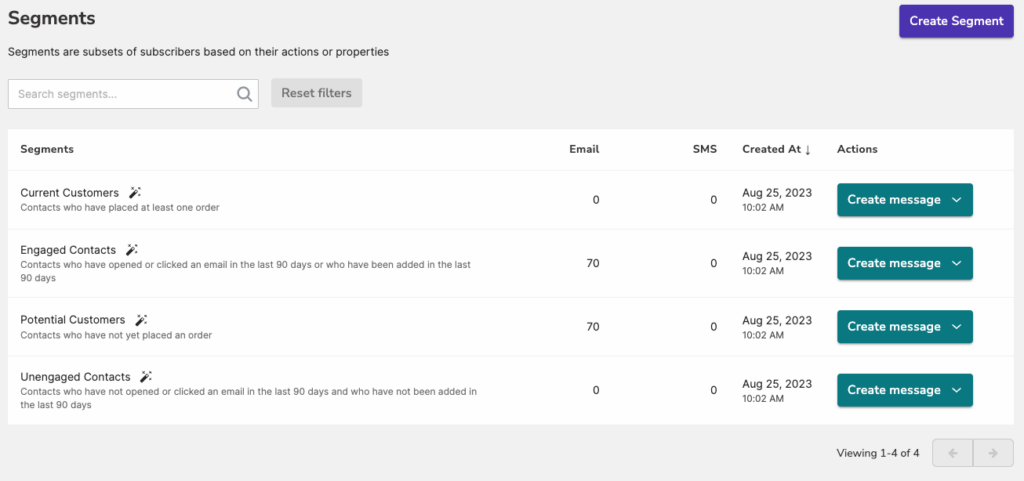
While Privy’s segmentation is less robust than Klaviyo’s, we find it more suitable for ecommerce beginners. And this is why.
Privy offers segmentation for most often ecommerce cases. It allows you to segment your list based on customer engagement. Additionally, you can organize your audience based on their shopping behavior, like:
- Lifetime spend
- Order value
- Order count
Privy covers many criteria to help you target your audience more effectively. This includes website behavior and customer attributes.
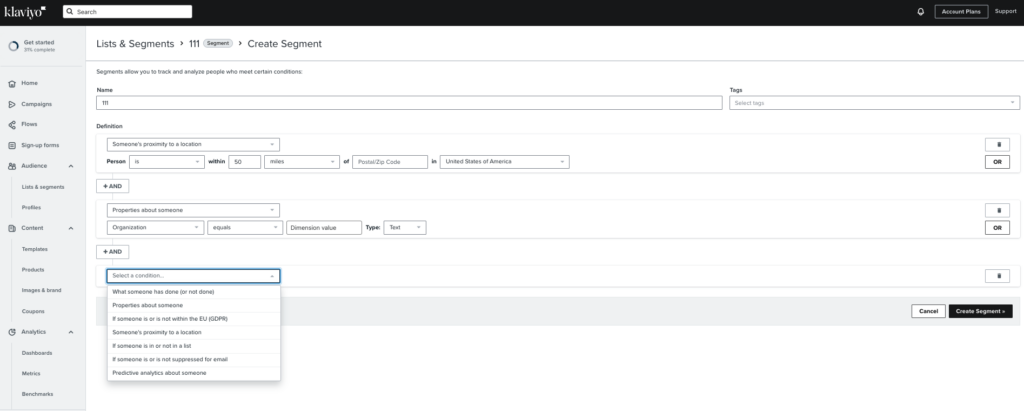
On the other hand, Klaviyo’s segmentation options cover a wide range, including:
- Actions taken or not taken by someone
- User properties (custom attributes you define)
- GDPR compliance for EU residents
- Proximity to a location
- Inclusion or exclusion in a specific list
- Email suppression status
- Predictive analytics insights
Klaviyo’s robust segmentation capabilities allow you to apply an extensive list of conditions to your segments. It provides you with precise control over your audience targeting.
However, it’s worth noting that you might need time to fully understand and leverage all its options and capabilities.
Klaviyo has a more powerful segmentation functionality than Privy. If you seek advanced message tailoring, Klaviyo wins over Privy.
Analytics
Privy provides basic email engagement activity metrics. You can track metrics like opens, clicks, unsubscribes, revenue generated, and the number of campaign orders.
While these metrics offer a foundational understanding of campaign performance, Privy has limitations regarding advanced analytics features.
Klaviyo, on the other hand, excels in the analytics department, providing comprehensive reporting capabilities.
Klaviyo’s reporting covers a wide range of metrics, from campaign engagement and conversion metrics to website visits and more. You can even schedule custom reports to receive them via email, with up to 10 reports available per user per account.
One of Klaviyo’s standout features is predictive analytics. This advanced tool helps predict various customer-related factors, such as:
- Date of the next order
- Lifetime value
- Probability of churning
- Spending capacity
- Anticipated demographics
Klaviyo’s Benchmarks feature also allows you to compare your campaign performance with others in your industry, providing valuable insights into how your efforts stack up against competitors.
Both tools have their limitations, however. Privy doesn’t offer geolocation or device reports, which can provide valuable insights into your audience is location and what devices they use to engage with your emails.
Additionally, in-depth ecommerce insights are missing, limiting the depth of understanding regarding customer behavior and purchase patterns.
While Klaviyo’s analytics offerings are extensive and insightful, the depth of data and the range of options might be overwhelming for beginners who aren’t accustomed to in-depth analysis.
Klaviyo comes out on top. It offers comprehensive features such as predictive analytics and benchmark comparisons.
Customer support
Privy provides customer support primarily to paid plan users. On these plans, you’ll have access to email and chat support. An interesting perk is that once your email contacts reach 9,000 or more, you gain access to 1:1 support.
However, for users on the free plan, support is limited, and there have been reports of less responsive support on Shopify.
Privy provides various independent resources, such as knowledge bases and guides, to supplement its support offerings.
On Klaviyo’s free plan, you’ll get email support for the initial 60 days, allowing new users to familiarize themselves with the platform.
For those on paid plans, email and chat support are available 24/5. However, both Klaviyo and Privy don’t offer phone support, which could be a limitation for users who prefer direct communication.
It’s worth noting that some users have reported that Privy’s and Klaviyo’s support response times can be on the slower side, which might impact your ability to swiftly resolve issues.
It’s a tie.
Integrations
Privy provides eight direct integrations, which is quite limited compared to Klaviyo’s 300+ integrations. While Privy offers integrations with important ecommerce and marketing tools, the overall choices are somewhat limited in comparison.
On the other hand, Klaviyo’s comprehensive list covers many different platforms, allowing users to seamlessly connect Klaviyo with additional tools for ecommerce, marketing, CRM, and analytics.
Klaviyo wins by a wide gap. It surpasses Privy with its vast list of integrations.
Compatibility with other marketing channels
Privy focuses primarily on email marketing and offers the option to send SMS at an additional charge. While this SMS feature can be useful, Privy’s scope is limited regarding integrated marketing channels.
On the other hand, Klaviyo offers a more comprehensive approach to omnichannel marketing. It provides users with the ability to send not only emails but also SMS and app push notifications.
This expanded reach allows businesses to engage with their audience through various communication channels, enhancing customer interaction and retention.
Additionally, Klaviyo features an integration option that allows you to perform Facebook and Google retargeting, enabling you to extend your marketing efforts to social media platforms. This integration enhances brand visibility and targeting capabilities, expanding the reach of marketing campaigns.
Klaviyo wins here. It offers broader omnichannel marketing capabilities, including email, SMS, app push notifications, and integrations.
Price Comparison
Achieving the right balance between features, usability, and cost is crucial for businesses of all sizes. In this section, we’ll delve into the pricing structures of Privy and Klaviyo.
Free plans comparison
Privy’s free plan offers a starting point for newcomers, supporting up to 100 contacts. This option provides access to essential features, including the use of popups.
Klaviyo’s free plan, on the other hand, offers a broader scope, accommodating up to 250 contacts while still granting access to all features.
Here’s a side-by-side comparison of Privy and Klaviyo free plans:
- Up to 100 mailable contacts
- Access to all popup types
- Advanced popup targeting
- Sync with email service providers
- Sync with Shopify coupons
- Up to 250 contacts
- 500 monthly email sends
- The vast majority of platform features
- Mobile push notifications (beta)
- Built-in CDP
- 150 free monthly SMS/MMS credits
- Email support for first 60 days
Paid plans comparison
Here’s a quick Privy vs Klaviyo pricing comparison:
Being honest, Privy’s pricing is quite confusing: the plan description determines some limitations for contact and SMS recipient numbers, but the price calculator allows adding a higher number of them. It takes time to understand the final price.
Meanwhile, Klaviyo has a more clear pricing. It is more flexible and approachable than Privy’s.
Both platforms are at the higher end of the price range. They aren’t the cheapest. However, considering their functionality, they are both worth a try.
Privy vs Klaviyo: Which one wins?
Let’s quickly review the Privy vs Klaviyo comparison to help you make an informed decision.
3.7
4.6
500 subscribers – $30
1,000 subscribers – $30
5,000 subscribers – $90
10,000 subscribers – $165
50,000 subscribers – $540
100,000 subscribers – $840
500 subscribers – $20
1,000 subscribers – $30
5,000 subscribers – $70
10,000 subscribers – $80
50,000 subscribers – $650
100,000 subscribers – $790
- Up to 100 mailable contacts
- Access to all popup types
- Advanced popup targeting
- Sync with Email Service Providers
- Sync with Shopify coupons
- Up to 250 contacts
- 500 monthly email sends
- The vast majority of platform features
- Mobile push notifications (beta)
- Built-in CDP
- 150 free monthly SMS/MMS credits
- Includes applicable SMS carrier fees
- Email support for first 60 days
- Extended list of signup forms
- Advanced signup forms functionality
- Intuitive email builder and the entire system interface
- Robust segmentation
- Pre-built signup forms and automation workflows that can work out of the box
- Beautiful email templates
- Very good analytics and reports
- Outstanding segmentation
- Basic automation
- Can’t combine email and SMS in one workflow
- Incomplete reporting
- Expensive
- It doesn’t have unique coupon codes
- No marketing gamification options
- This tool gets expensive very quickly
- For beginners the learning curve might be too steep; it’s more for advanced users
- Ecommerce beginners with the main focus on growing their contact list
- Bloggers
- Ecommerce
- Advanced users
- Established ecommerce businesses
- Companies with large contact lists
- Email marketing beginners
- Marketers on a budget
- Non-profit organizations
Privy and Klaviyo offer distinct advantages and limitations. Privy is user-friendly, and suitable for beginners and small businesses, while Klaviyo is feature-rich, targeting experienced marketers and larger enterprises.
Privy provides a straightforward interface, templates, and automation. Klaviyo offers advanced automation and personalization. Your choice depends on your needs, expertise, and budget.
Ultimately, while Privy might be a good choice for beginners, Klaviyo offers more robust features for those aiming higher, similar to Omnisend. However, we advise you to carefully consider all the parameters we’ve discussed before making a decision.
Read full reviews
Related picks for you
Our team strives to be accurate and unbiased in reviewing email tools. However, we recognize that mistakes can happen, and it’s essential for us to stay up to date. If you come across any errors or things that need to be reviewed again, please let us know.





Leave a Reply